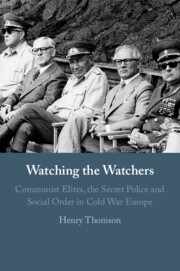Book contents
- Frontmatter
- Dedication
- Contents
- Figures
- Tables
- Acknowledgments
- Part I Introduction and Theory
- Part II Comparative Historical Analysis: Polish People’s Republic and the German Democratic Republic
- 3 Introduction to Part II
- 4 The Polish People’s Republic
- 5 The German Democratic Republic
- Part III Cross-national Quantitative Analysis
- Part IV Conclusion
- Appendix A Secret Police Agencies and Chiefs in Socialist Central and Eastern Europe, 1945–1989
- Appendix B Survival Analysis, Chapter 7
- Appendix C Agency Size Analysis, Chapter 8
- Bibliography
- Index
3 - Introduction to Part II
from Part II - Comparative Historical Analysis: Polish People’s Republic and the German Democratic Republic
Published online by Cambridge University Press: 22 February 2024
- Frontmatter
- Dedication
- Contents
- Figures
- Tables
- Acknowledgments
- Part I Introduction and Theory
- Part II Comparative Historical Analysis: Polish People’s Republic and the German Democratic Republic
- 3 Introduction to Part II
- 4 The Polish People’s Republic
- 5 The German Democratic Republic
- Part III Cross-national Quantitative Analysis
- Part IV Conclusion
- Appendix A Secret Police Agencies and Chiefs in Socialist Central and Eastern Europe, 1945–1989
- Appendix B Survival Analysis, Chapter 7
- Appendix C Agency Size Analysis, Chapter 8
- Bibliography
- Index
Summary
This chapter introduces the research design and comparative case studies in Part II of the book. In this part of the book, I present historical case studies of Poland and East Germany. This is the qualitative component of the integrated, multimethod difference-in-difference research design with which I test the theoretical propositions laid out in Chapter 2. The first case experienced a post-Stalinist transition, while the second did not. By carefully tracing developments in elite cohesion and coercive capacity across the two otherwise very similar cases, I demonstrate that post-Stalinist transitions caused reductions in coercive capacity. I do so by showing that trends in capacity were similar across the Polish and East German regimes before 1953; that post-Stalinist transitions occurred randomly and were not themselves a function of coercive capacity; and by tracing the causal mechanisms that linked transitions to declines in capacity.
Keywords
- Type
- Chapter
- Information
- Watching the WatchersCommunist Elites, the Secret Police and Social Order in Cold War Europe, pp. 93 - 99Publisher: Cambridge University PressPrint publication year: 2024

